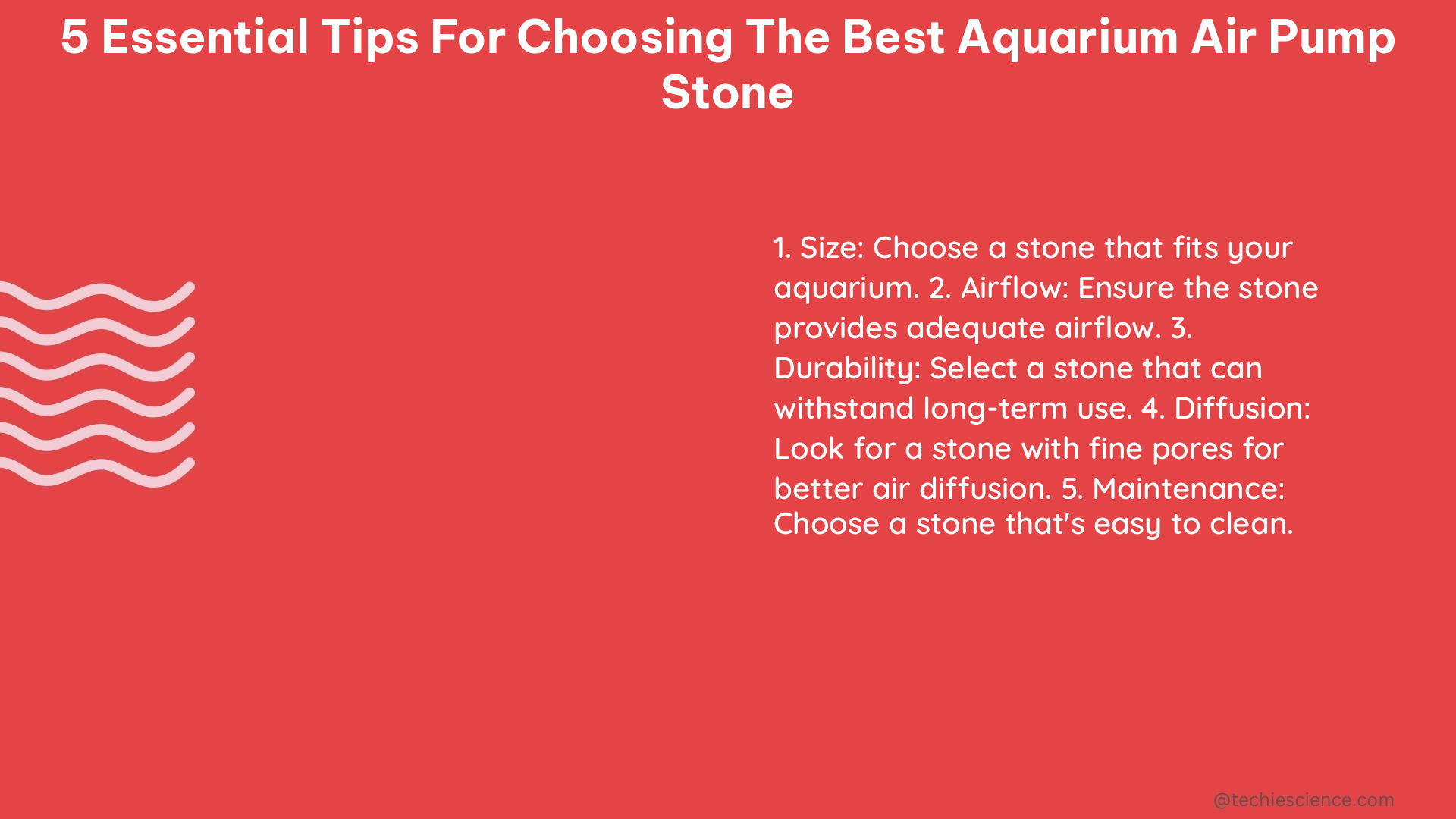When setting up an aquarium, choosing the right air pump stone is crucial for maintaining a healthy and thriving underwater ecosystem. This comprehensive guide will provide you with five essential tips to help you select the best air pump stone for your aquarium.
1. Determine the Appropriate Tank Size
The size of your aquarium is a critical factor in selecting the right air pump stone. Larger tanks require more powerful air pumps to ensure adequate airflow and oxygenation. Here’s a breakdown of the recommended air pump sizes based on tank volume:
| Tank Size (Gallons) | Recommended Air Pump GPH |
|---|---|
| 5-10 | 10-20 GPH |
| 10-20 | 20-30 GPH |
| 20-40 | 30-50 GPH |
| 40-60 | 50-80 GPH |
| 60-100 | 80-120 GPH |
| 100+ | 120+ GPH |
It’s important to note that these are general guidelines, and the actual air pump requirements may vary depending on the specific setup and stocking levels of your aquarium.
2. Evaluate the Airflow Rate

The airflow rate, measured in gallons per hour (GPH), determines the amount of air supplied to the tank. Ensure that the air pump stone you choose has a GPH rate appropriate for your tank size. As a rule of thumb:
- Small tanks (< 15 gallons) require 10-20 GPH
- Medium tanks (15-40 gallons) require 20-30 GPH
- Large tanks (40+ gallons) require 30-50 GPH
Choosing an air pump with the correct airflow rate will help maintain optimal oxygen levels and water circulation in your aquarium.
3. Consider the Noise Level
Noise is an essential factor, especially for aquariums located in living spaces or bedrooms. Look for air pumps with low noise levels, typically measured in decibels (dB). Ideally, you should aim for air pumps with a noise output of less than 40 dB, which is considered relatively quiet.
Some popular quiet air pump models include:
- EcoPlus Commercial Air 1: 35 dB
- EcoPlus Commercial Air 3: 38 dB
- Tetra Whisper Air Pump: 40 dB
Paying attention to the noise level will ensure a peaceful and relaxing environment for both you and your aquatic inhabitants.
4. Prioritize Energy Efficiency
The air pump stone will be running continuously, so it’s essential to consider its power consumption. Look for energy-efficient models that consume minimal electricity, typically ranging from 2 to 5 watts. This will not only save you money on your electricity bills but also reduce your aquarium’s overall environmental impact.
Some energy-efficient air pump options include:
- Tetra Whisper Air Pump: 2.5 watts
- Aqueon Air Pump: 3 watts
- Fluval Q1 Air Pump: 4 watts
By choosing an energy-efficient air pump, you can enjoy long-term cost savings and a more sustainable aquarium setup.
5. Ensure Durability and Material Quality
The air pump stone should be made of durable materials that can withstand the aquarium environment. Look for air pumps constructed with high-quality plastics or aluminum, as these materials are less prone to corrosion and wear over time.
Additionally, consider the air stone itself, which is the porous component that diffuses the air into the water. Opt for air stones made from materials like ceramic, sintered glass, or porous stones like lava rock, as they are more resistant to clogging and can provide a consistent airflow.
By following these five essential tips, you can confidently select the best air pump stone for your aquarium, ensuring optimal oxygenation, water circulation, and long-term reliability.
DIY Air Pump Stone Considerations
If you prefer a more hands-on approach, you can also create a DIY air pump stone for your aquarium. Here are some additional tips to consider:
- Use a small water pump or repurpose an old aquarium air pump as the air source.
- Construct the air stone using porous materials like lava rock, ceramic, or a mesh bag filled with small pebbles.
- Ensure the DIY air pump stone is securely attached to the aquarium to prevent leaks and maintain a stable airflow.
Technical Specifications Summary
To summarize the key technical specifications to consider when choosing an air pump stone:
- Tank Size: 5-10 gallons to 100+ gallons
- Airflow Rate: 10-20 GPH to 120+ GPH
- Noise Level: Typically under 40 dB for quiet operation
- Power Consumption: 2-5 watts for energy-efficient models
- Materials: Aluminum, high-quality plastic, ceramic, sintered glass, lava rock
By keeping these technical details in mind, you can make an informed decision and select the best air pump stone for your aquarium’s specific needs.
References:
– What Is an Aquarium Air Pump and Is It Necessary? (2022-03-03). Retrieved from https://www.freshwatersystems.com/blogs/blog/what-is-an-aquarium-air-pump-and-is-it-necessary
– 5 Best and Quietest Aquarium Air Pumps (60+ Tested!) – FishLab. Retrieved from https://fishlab.com/aquarium-air-pump/
– A COMPREHENSIVE GUIDE TO AQUARIUM AIR PUMPS – TUNAI. Retrieved from https://tunai.in/blog/f/a-comprehensive-guide-to-aquarium-air-pumps-choosing-the-best-ai
